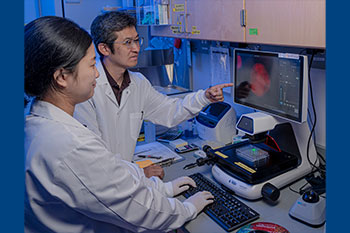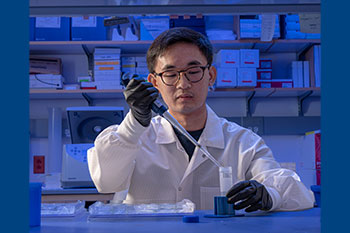Shining a Light on Cell Transformation with 3D Technology: Dr. Jung Wook Park

Jung Wook Park, PhD, is at the forefront of innovative research in prostate cancer. Motivated by childhood curiosity and a familial encounter with pancreatic cancer, Park's journey led him to explore the intricacies of cancer biology, with a focus on understanding and manipulating DNA to stop cancer progression.

From studying human papillomavirus (HPV) at the University of Wisconsin-Madison to working with human tissue samples at the University of California-Los Angeles, Park found a natural fit at Duke, where he was named as the first recipient of Duke's Rollie Endowed Assistant Professorship, which was generously funded by long-time, esteemed faculty couple Sara Miller, PhD, and David Howell, MD, PhD. His work benefits from diverse patient populations and thrives on collaborative opportunities within the Duke community.
As a principal investigator in his lab at Duke, Park employs a unique approach, studying both cancer cells and the surrounding healthy tissue. His innovative ex vivo 3D organoid culture system allows for a controlled environment to observe the transformation of healthy cells into cancer cells.
Emphasizing the unique advantages of his position, Park shared, “Being part of the Duke Pathology Department is great because I can get samples of both diseased and healthy tissue from the doctors who are mainly focused on a patient’s disease.” This method sheds light on the complexities of prostate cancer development and treatment resistance.

Park envisions his research as a crucial part of the larger cancer-fighting effort, aiming to detect cancer at its earliest stage for more effective interventions. His ultimate goals are connected to early detection in order to prevent one type of cancer from transforming into another, and to provide hope for patients battling cancer.
Awards and Honors:
- Department of Defense (DoD) Cancer Idea Development Grant for his research titled, “Defining Cellular and Genetic Factors for Renal Cell Carcinoma Subtypes”
- DOD grant titled, “Transcriptional Reprogramming of Lethal Small Cell Prostate Cancer”
- Prostate Cancer Foundation grant titled, “Interrupting the Aberrant Cancer Development Sequence in Epithelial Cancer Progression”
- National Institutes of Health grant titled, “Defining the Essential Determinants of Prostate Cancer Differentiation States”
- Mike Slive Foundation grant titled, “Unveiling the Roles of Neuroendocrine Cells in Prostate Cancer Development”